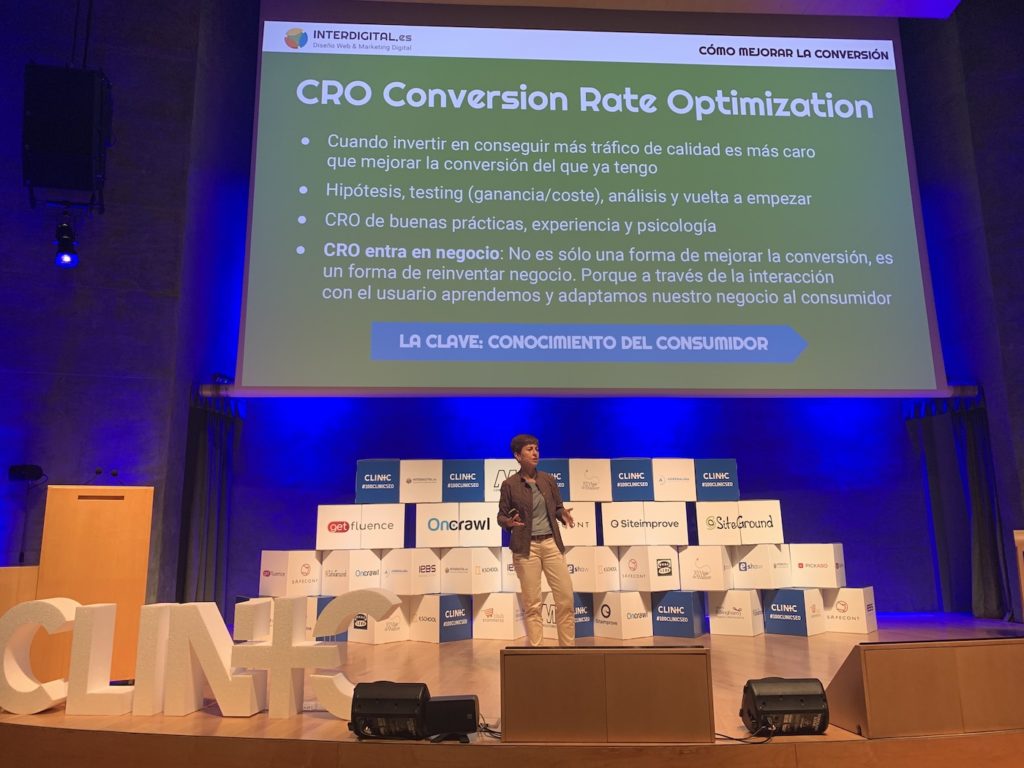Written by Fernando Maciá
Index
Marta Soler, CEO of Interdigital.
We talk about CRO: conversion optimization on the home page of the site to maximize results.
What is CRO
The CRO generates hypotheses, we test them and start again.
We make decisions based on instincts, emotions and, ultimately, guided by reason. Websites must be easy to use, intuitive. But not only that: the proposal must be associated with what motivates my user. The user wants what motivates him. But before making the purchase decision, we will also reflect and reason if it is the best purchase option.
But it’s the Disney princess that makes the decision: emotion over reflection, because it’s aligned with my motivation.
We need to know the target customer in order to align our value proposition with their base motivations. They are articulated from motivation to emotion.
How decisions are made
When we are not aware of the problem, we need to create the need: welcome to the big screen (iPhone) is a slogan that makes us want to change phones. Then I will look at the features and the price, which corresponds to the reasonable part. I will not look at anything if I am not previously motivated and excited.
99% in automatic
Most of our actions are automatic: we go in automatic mode. Common sense and good practices have a lot to do here. Contrast, three-click rule, performance and download speed, etc.
If we are in transactional models, data capture should have minimal friction. We only ask for the necessary data. We must be aware of what we ask for and what we give. If the reward is juicy, we can ask for more.
The triggers: that thing that convinces me to buy now because “there are only two left”, or because the offer is over… Be credible and sociable, but not obsessive.
Principles of persuasion
- Of reciprocity: give something first to create the need for compensation.
- Commitment: be consistent in your presentation of brand values and your relationship with the user. One of the ways to achieve this is with marketing automation.
- Social approval: if many people have voted in favor of an item, it is easier for me to adhere to making the same decision as them.
- Empathy: if we talk about you, we create distance. We make it more difficult for the user to move forward because we separate ourselves from him. We must stay close to him and create human warmth.
- Authority: especially for brands that are not well known. This is the way to provide credibility.
- Scarcity: Booking is an artist in creating the feeling of scarcity. There are only two left, seven more people are watching….
All of these are triggers that lead to conversion.
Fears, certainties and doubts
Close to the CTAs, we place the counterobjectives: fast shipping, returns, guarantees, non-permanence, etc.
To know the consumer well you have to go out and talk to the consumer: Marta Soler recommends Mental models from Indi Young on how to interact with consumers to get to know them better.
Where to start
- What needs do you have for me? What are you doing here for me?
- Is it for me?
- Why you?
- Explain more
- Fears, uncertainties and doubts
Secondary targets.
Focus your presentation on the user and empathize. The first impression will mark the entire relationship.
We must balance messages according to the maturity of the market. If the user does not know what we offer, we must focus on the what. When development is more advanced, we must make claims and argue why. In saturated markets, we must focus on the brand.
Where do we have consumer knowledge?
The information is scattered in different media. This information generates scattered and disjointed campaigns. It is impossible for them to be effective. We need marketing automation tools.
The web reacts to the user. He adapts to it, learns from it and manages to reinvent the business. The only way to do this effectively is to fully digitize the customer journey, communicating appropriately at every point of contact with the customer.
